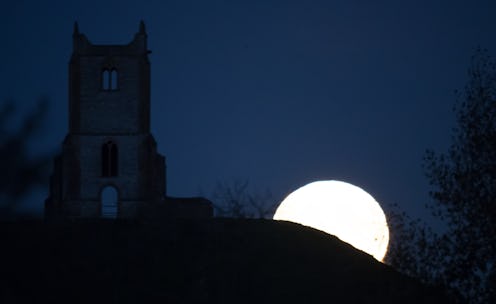Life
This Is Why People Are Freaking Out About The Full Moon Happening On New Year's Day

There are lots of reasons to look forward to the end of the year, like Best Of lists, NYE parties, DJ Earworm's annual United States of Pop mashup, and New Year's resolutions I definitely will not break by February. But the start of 2018's got an extra-special treat - a Wolf Moon, i.e. the first of two full moons we're blessed with in January, which crests between January 1st and 2nd. So what does it mean if there's a full moon on New Year's Day?
Well, it sort of depends on what you're looking for. Scientifically, all the New Year's moon means is that the 354-day lunar calendar lines up with our 365-day Gregorian calendar — which basically exists just to make sure Easter aligns somewhere with the spring equinox — in such a way that we get two full moons in January. It takes the moon about 27.3 days to orbit the earth, and lunations, i.e. full lunar phase cycles, i.e. how we see the moon from earth depending on where it is in orbit, are only about 29.5 days, Gregorian months, with the notable exception of February, are 30 and 31 days, so if there's a full moon super early in a month there's a good chance we'll get a second one before the month's end. That second moon is what we call a "Blue Moon," and despite its cultural prominence thanks to a popular saying you've probably heard a couple of times, it's not really that rare.
So that's the deal on a purely celestial level. Historically, the Wolf Moon gets its name from the Native American tribes in the north and in the east, who noticed wolves, who were particularly hungry in the early January cold, gathering in packs to howl at it (it's noteworthy that wolves do not necessarily howl at the moon, but they do look up to howl, hence the mistaken attribution.)
The Wolf Moon's got some other names, including the Ice Moon (because it's cold), the Moon After Yule (because January follows Christmas), the Hunger Moon (because of the hungry wolves) the Snow Moon (because it, well, snows) and the Old Moon (origin unclear.)
Symbolically, there's a lot more to unpack here. First, it's noteworthy that certain spiritual sects believe that when January's full moon rolls in, it means the month's at its coldest, darkest, and bitterest which, considering how frigid the northeast is right now, makes a certain amount of sense, even if this coming moon's a little early. On the bright side, maybe January will warm up?
The Wolf Moon is also considered a sign that you should to listen to your intuitions, better communicate with your friends and loved ones, and focus on how to fine-tune your weaknesses — all things at which social and resourceful wolves are skilled. Starting the year off this way surely portends for an enterprising 2018.
Astrologically, New Years' full moon offers a slew of possibilities for the year to come. If you're curious to know what's specifically in store for you based on your sign, we've got you covered. But in general, the upcoming full moon will rise in Cancer, which serves as a homecoming of sorts, making the new year a good time to get cozy with the people you love. The rising moon is also going to oppose Venus, which means you may start sensing some dissatisfaction in your social relationships this year. And though that sounds like a bad thing, really it means you'll have an opportunity to trade in toxic friendships, stale romantic relationships, and other entanglements that no longer seem to make you happy for ones that do, which, in the long run, is a very good thing.
In addition to cutting ties with bad relationships, a New Year's Day full moon also gives you permission to clear out bad habits, useless time-wasters, and patterns that have run dry, giving you more room to build better, more productive habits, relationships, career goals, and other fun stuff that'll make 2018 a far more promising year than this last one.